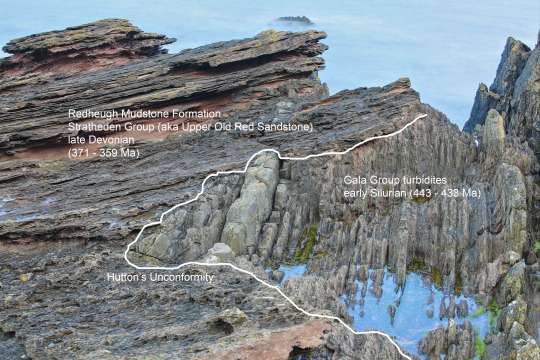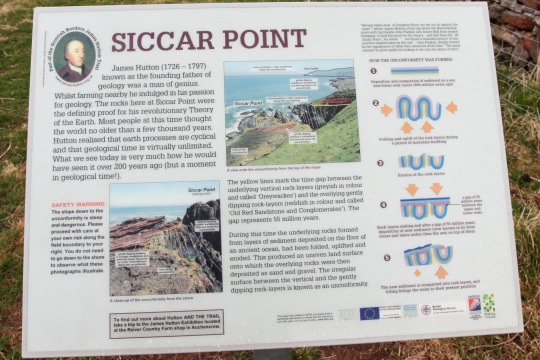#siccar point
Explore tagged Tumblr posts
Text



2013: From looking at Google Maps, the signage has not been updated in the last 10 years changing the stated duration of the unconformity of 55 million years to a more likely value (according to IUGS) of approx 75 million years? Siccar Point is one of the top 100 Geoheritage sites in the world.
148 notes
·
View notes
Text
Trying to not being annoying in my anthropology class when we start talking about fossils
2 notes
·
View notes
Text
youtube
In the 1700s, geologist James Hutton discovered a rock formation in Scotland that transformed how we think about time.
Through studying the rocky headland of Siccar Point, Hutton identified the existence of ‘deep time’ – proving that Earth is millions, not thousands, of years old.
3 notes
·
View notes
Text
What clearer evidence could we have had of the different formation of these rocks, and of the long interval which separated their formation, had we actually seen them emerging from the bosom of the deep? ... The mind seemed to grow giddy by looking so far into the abyss of time; and while we listened with earnestness and admiration to the philosopher who was now unfolding to us the order and series of these wonderful events, we became sensible how much farther reason may sometimes go than imagination can venture to follow.
- John Playfair on Siccar Point

These rocks are from a time before eyes, brains, and bones, pieces of a land warmed by an unseen sun.
Proterozoic Rocks [Explained]
Transcript Under the Cut
[Cueball is seen at a distance, walking amid a rocky landscape.] I love being near Proterozoic rocks. These ones are 1.1 billion years old. That's so, so old.
[Cueball standing next to a rock.] Eyes evolved half a billion years ago. The first time a rock was ever looked at, these rocks were already 500 million years old.
[Cueball sitting atop a large rock.] People say geologic time makes them feel small. But when I touch this rock, it's like I'm a part of it, spanning a vast abyss of time that stretches back as far as the eye can see.
[A completely black panel except for text in white lettering.] And then 500 million years farther.
#geology#yeah#quoting playfair because i like his writing and also this is much harder to misinterpret then hutton's#somewhat infamous time quote
842 notes
·
View notes
Photo

Additional Rock Facts: this, here shown covered in geology students (it’s an old photo), is Hutton’s Unconformity at Siccar Point, a small headland in the Scottish Borders just east of Pease Bay Caravan Park. Also named after James Hutton; dude got around. The significance of this one is that, as an angular unconformity (i.e., the rocks are of different ages and don’t line up), the differing directions of the strata show that a) geological deformation has changed the orientation of the older rocks (behind the person in the middle) from how they were originally laid down and b) there have been lengthy interruptions in the process of sedimentary deposition. This may seem obvious to us today but in Hutton’s time it was contrary to the accepted wisdom that the rocks we see today were deposited after the single cataclysmic flood of Noah’s Ark fame. The person with the blue rucksack is sitting at the margin; the older grey rocks were lifted up so that the strata were vertical, erosion smoothed out the surface, and then the reddish rock was laid down on top.
155 notes
·
View notes
Video
vimeo
Siccar point by drone. Original caption:
Not far from Edinburgh, Siccar Point is a rocky promontory that has become a place of pilgrimage for geologists from across the globe.
James Hutton, father of modern geology, visited Siccar Point by boat in 1788, an event which led to a profound change in the way the history of the Earth was understood.
A man ahead of his time, James Hutton used the evidence from Siccar Point to decode Earth processes and to argue for a much greater length of geological time than was popularly accepted. As John Playfair later recorded of their visit “The mind seemed to grow giddy by looking so far into the abyss of time”. A concept of ‘deep time’ emerged with the recognition that the geological processes occurring around us today have operated over a long period and will continue to do so into the future.
James Hutton found the decisive evidence he sought for his Theory of the Earth, Hutton’s Unconformity, the never-ending cycles of creation and destruction that shape our landscape today.
Hutton’s theory overturned the last vestiges of the Biblical account of a world shaped by the receding waters of a universal flood. Controversial in its day, Hutton’s work is now a foundation stone in the science of geology.
You can visit Siccar Point today, and see the spectacular junction between two distinctive types of rock, just as Hutton himself found it.
Client: Dynamic Earth / Juniper Leaf Education Production & Post: Play North Music: Kai Engel | Marée | Brum
#siccar point#rock#geology#scotland#nature#travel#video#drone#vimeo#landscape#outdoors#unconformity#angular unconformity#hutton's unconformity#james hutton#history#the earth story
86 notes
·
View notes
Text
Scotland 2019
Here's the trip diary of our recently completed "Scotland: Birth of Geology" tour – read about our visit to the world’s most important historic geological sites
Scotland: The Birth of Geology
In July 2019 we led our Geology of Scotland tour for the fourth time. Scotland has incredibly diverse geology – it was here that the enormity of geological time was first envisaged, the first attempts to measure the mass of the Earth were made, Thrust Faults were discovered and middle Jurassic Dinosaurs roamed.

GeoWorld Travel’s ‘Scotland: The Birth of…
View On WordPress
#Assynt#Cuillin#Dinosaurs#Edinburgh#Gabbro#geology#Glencoe#Isle of Skye#Knockan Crag#Moine Thrust#North West Highlands Geopark#Salisbury Crags#Scotland#Siccar Point#Staffa#Strontian#Strontium#volcano
1 note
·
View note
Photo

Siccar Point on Mars #NASA https://ift.tt/gXwlGVT
0 notes
Photo






2013: Name a more famous outcrop in geological science.
177 notes
·
View notes
Photo

2022 August 31
Siccar Point on Mars Image Credit: NASA/JPL-Caltech/MSSS; Processing & License: Kevin M. Gill
Explanation: What created this unusual hill on Mars? No one is sure. A good outlook to survey the surrounding area, Siccar Point stands out from its surroundings in Gale Crater. The unusual mound was visited by the robotic Curiosity rover exploring Mars late last year. Siccar Point not only has a distinctive shape, it has dark rocks above lighter rocks. The apparent much younger age of the dark rocks indicates a time-break in the usual geological ordering of rock layers -- by a process yet unknown. The Martian hill is named for Siccar Point on Earth, a place in Scotland itself distinctive as a junction between two different rock layers. Curiosity continues to explore Gale crater on Mars, looking for clues of ancient life. Simultaneously, 2300 kilometers away, its sister rover Perseverance explores Jezero crater, there assisted by the flight-capable scout Ingenuity.
∞ Source: apod.nasa.gov/apod/ap220831.html
52 notes
·
View notes
Photo

Siccar Point on Mars via NASA https://ift.tt/8pwMQ2C
35 notes
·
View notes
Text
The Poetics of Deep Time:
“One of the defining statements on the Anthropocene within the humanities has been Dipesh Chakrabarty’s assertion that humans have become “geological agents,” partners with planetary systems in shaping Earth's deep future. Yet all living things are creatures of deep time, the inheritors of a legacy of infinitesimal slow change. Chapter 1 explores the intimacy that inheres within the deep time of geologic and evolutionary processes. Thick time refers to the lyric's capacity to put multiple temporalities and scales within a single frame, to “thicken” the present with an awareness of the other times and places. Elizabeth Bishop and Seamus Heaney demonstrate how the thick time of the lyric now allows us to imagine the complexity and richness of our enfolding with deep-time processes and explore the sensuous and uncanny aspects of how deep time is experienced in the present.
Since the idea was first put forward by James Hutton, deep time has been encountered through textures and characterized by a sense of vertigo. The “geologic sublime” is almost a cliché; yet even in John Playfair’s famous, astonished remark on seeing Hutton’s unconformity at Siccar point in 1788 - “the mind seemed to grow giddy by looking so far into the abyss of time” - there is the intimation of something even more strange: “We felt ourselves necessarily carried back to the time when the schistus on which we stood was yet at the bottom of the sea, and when the sandstone before us was only beginning to be deposited, in the shape of sand or mud, from the waters of a superincumbent ocean.” The rock dissolves to sediments; as Playfair imagines himself witness to its formation, he also bears witness to rock’s fluidity. In this early vision of deep time, which has echoed ever since in the geologic imagination, a series of transformations and breaches takes place: the lithic becomes liquid; the weight of water replaces the weight of stone; the body is submerged by rock and sea. Sensuous, fascinated by texture and the possibilities of multiscalar perspective, Playfair’s vision is geophiliac in its attention to stone’s mutability.
...If Chakrabarty’s statement shows how the Anthropocene and its associated crises are a problem for the humanities, indicating a shift in what constitutes the human, the work of Yusoff and Nigel Clark offers the possibility that life, and what it means to be human, has always had a geologic aspect. From habitable landmasses shaped by volcanism to the origins of human culture in Neolithic art daubed in minerals onto cave walls, we have entered our inheritance as human via our relationship with the lithic.”
David Farrier, Anthropocene Poetics, 2019
31 notes
·
View notes
Text
Siccar Point on Mars

What created this unusual hill on Mars? No one is sure. A good outlook to survey the surrounding area, Siccar Point stands out from its surroundings in Gale Crater. The unusual mound was visited by the robotic Curiosity rover exploring Mars late last year. Siccar Point not only has a distinctive shape, it has dark rocks above lighter rocks. The apparent much younger age of the dark rocks indicates a time-break in the usual geological ordering of rock layers -- by a process yet unknown. The Martian hill is named for Siccar Point on Earth, a place in Scotland itself distinctive as a junction between two different rock layers. Curiosity continues to explore Gale crater on Mars, looking for clues of ancient life. Simultaneously, 2300 kilometers away, its sister rover Perseverance explores Jezero crater, there assisted by the flight-capable scout Ingenuity.
Image Copyright: Image Credit: NASA/JPL-Caltech/MSSS; Processing & License: Kevin M. Gill
3 notes
·
View notes
Photo

Siccar Point
The US Geological Survey’s Landsat 8 satellite captured this image of Siccar Point in Scotland, perhaps the most famous angular unconformity on Earth. At this site, naturalist James Hutton recognized that the presence of an angular unconformity required millions of years of Earth history – the first layer of rocks had to be formed, tilted, and eroded, before another layer could be deposited on top. What I particularly like about this image is that if you look along the shoreline to the west of Siccar point, you can actually see the pattern created by the dipping beds of the Old Red Sandstone. There are linear outcrops all along the shoreline that outline the intersection of those beds with the surface – that direction is what geologists call the strike. It even looks like one of the creeks follows that direction for a short distance. To the right of Siccar point, you can no longer see this pattern, as the older and steeper beds strike in a different direction.
JBB
For more on Siccar point, see our previous posts: https://tmblr.co/Zyv2Js11Z9mNF https://tmblr.co/Zyv2Js1R6HJsL https://tmblr.co/Zyv2Js221GUwo
Image credit: https://earthobservatory.nasa.gov/images/92598/the-abyss-of-time
#Siccar point#scotland#geology#unconformity#angular unconformity#old red sandstone#nature#strike#travel#earth from space#landsat#history#geologist#thee arth story
115 notes
·
View notes
Text
Scotland 2021
We've just published the blog of our recently completed geology tour of Scotland.
After a 14-month hiatus, due to the global pandemic, GeoWorld Travel finally got back on the road again, with a small group, socially distanced tour of the geology of Scotland. For geologists the world over, Scotland offers a wealth of outstanding geological sites and has been host to a number of crucial events in the history of geology. The route map for our ‘Birth of Geology’…

View On WordPress
#dinosaur footprints#Fingals Cave#geology#geology holiday#geology tour#geotour#geotourism#Moine Thrust#Scotland#Siccar Point#Staffa
0 notes
